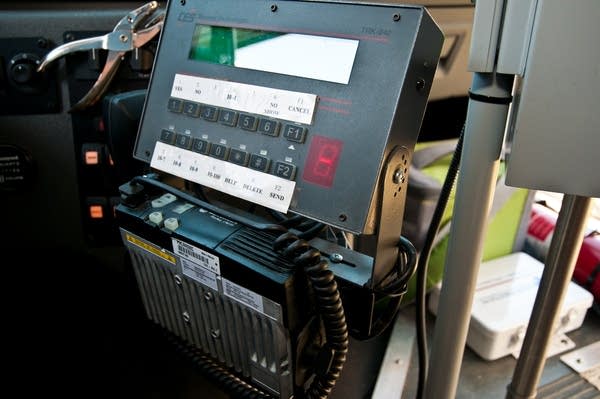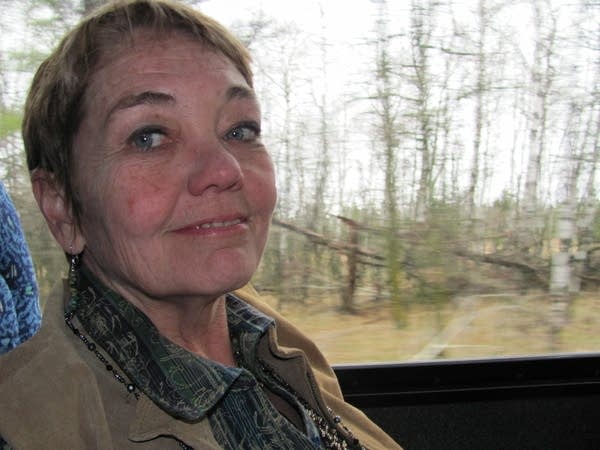High tech transit emerging in the woods
Go Deeper.
Create an account or log in to save stories.
Like this?
Thanks for liking this story! We have added it to a list of your favorite stories.

Bus driver Roger Hocking passes groves of pine trees and even the occasional deer as he approaches and departs a string of home-based daycares at the outskirts of town. At one, a 5-year-old boy named Talen climbs aboard, chirps hello and casually tosses his backpack onto the pile of bags behind Hocking's seat.
The boy straps himself in to a plush blue seat in a way that says this is an old habit. His parents pay $1.50 for the ride to Talen's preschool at a Lutheran church, saving them from having to leave work to make the drive. "I like riding the bus," he says, as Hocking makes a left. "I like that it always turns this way."
When Hocking, a 64-year-old former Pamida manager with a gregarious streak, picks up a passenger, he says hello and punches a code into a panel mounted at the front of the bus. The box is connected to a dispatch center 45 miles away in Bemidji, which tracks his bus remotely as it rolls through the wooded community.
His bus system, the Hubbard County Heartland Express, works on a demand-response model, which means a person phones Bemidji for a ride, a dispatcher transmits the name and address to a driver via a small screen and the bus picks the rider up at the curb. They are mostly kids and seniors and people with disabilities headed to school, the store, the doctor or the courthouse.
Turn Up Your Support
MPR News helps you turn down the noise and build shared understanding. Turn up your support for this public resource and keep trusted journalism accessible to all.
Riders used to call Hocking directly on his cell phone for rides and he kept all the information in his head, occasionally pulling onto the shoulder to jot down a detail. The system was unwieldy and become even more so after a second bus was added. "I could get 100 phone calls in a day," said Hocking.
The decision to outsource dispatch to Paul Bunyan Transit a year ago ruffled feathers among some riders, but it made the job a little easier and serves as an example of how outstate Minnesota transit systems are trying to be more efficient.
RIDERSHIP IS UP

Those systems provided 11.5 million rides last year for an estimated operating cost of $61 million. Fares pay only a fraction of the expense and the perceived need is rising faster than available state and federal dollars. Getting people from here to there outstate can be daunting; the distances are great, the populations both sparse and aging. Gas prices have risen, driving up bus ridership and also operating costs, so the push is on to find new ways both to serve more people and to keep expenses down.
Ridership trends vary from one system to another, but overall, the numbers were up between 2 and 3 percent in 2011 after several years of decline, according to the Minnesota Department of Transportation. The last spike came in 2008, when gas prices approached $4 per gallon. "I remember 2008 so well," said Greg Negard, executive director of Paul Bunyan. "I was getting calls from people saying, 'I need to ride the bus.'" He attributes the latest ridership uptick partially to gas prices as well.
There is greater demand and need out there than we are able to meet, given our fiscal constraints
Rural transit budgets are paid for with a combination of local, state and federal dollars and supplemented by rider fares and ridership contracts with various public and private entities. In recent years, state and federal dollars have been largely stagnant, according to Tom Gottfried, MnDOT's Greater Minnesota Transit Program Director. "We always want the ridership. But there is greater demand and need out there than we are able to meet, given our fiscal constraints."
In rural areas, by far the majority of people drive to get where they are going. According to the Fargo-based Small Urban & Rural Transit Center, less than half of 1 percent of outstate trips are made by public transit, compared to almost 5 percent in bigger cities. But for those who can't or can't afford to drive, buses can be crucial, despite their limitations. Often they run only during the day, Monday through Friday. The Heartland Express covers Park Rapids on weekdays between 7:45 a.m. and 4:30 p.m. and only runs once a day through Nevis and Dorset and twice a month from Park Rapids to Bemidji. Several Minnesota counties have no public bus service at all.
A recent report from MnDOT determined that, as of 2009, only about 60 percent of outstate transit needs were being met. At the Legislature's behest, the agency investigated what it would take to meet 80 percent of needs by 2015 and 90 percent by 2025. It would be virtually impossible, however, to greatly expand ridership without an infusion of public dollars. "We're doing a little over a million hours right now," said Gottfried. "How do we pay for the last 800,000 hours? We do know that (those) hours are going to be more expensive. We're talking about the person who is harder to provide services to. We probably have taken care of most of the low hanging fruit."
Yet, some systems have found creative ways to increase revenues and ridership, at least a little, whether by sharing dispatch services and other administrative tasks, or by working out contracts with schools, daycare centers and others for regular rides.
MnDOT has placed an emphasis on efficiency as part of its "2012 and Beyond Initiative." The idea arose during the contentious state budget negotiations last year when it looked like public transit funding could be cut dramatically. That didn't happen, but MnDOT is pushing the new agenda anyway. People refer to it as the "3 Cs": coordination, cooperation and consolidation.
'WE KNOW WHO MABEL IS AND WHERE SHE LIVES'
If we don't serve them, how will they get around? We've got curb to curb service
Bev Herfindahl, a MnDOT project manager who focuses on outstate transit, holds up the Heartland Express and Paul Bunyan arrangement as a success story. "[Heartland] didn't have to hire a dispatcher," she said. "[They] could take those dollars and put them on the street. We could replicate that in other areas. It would be beneficial." She said she's asking other transit systems to "look at their neighbors and think about what they can do together."
Because of its contract with Paul Bunyan, which costs $1,281 per month, Heartland Express has been able to increase ridership by 17 percent without its buses driving many more miles and has also expanded the radius of regular city service outside Park Rapids by two miles.
The transition wasn't entirely smooth for riders used to calling Hocking directly, however. "At the call center, you had to push a number before you got a person," said Heartland's coordinator Linda Bair. "People complained. 'I'm talking to someone in Bemidji, why can't I talk to someone in Park Rapids?' It was like (dispatch) was in India. It felt like it wasn't their system anymore." Riders also had to get used to a 15 minute window around when the bus might come, rather than knowing the time exactly.
To make a more human connection, Bair began carrying photos of the Bemidji dispatchers to show Park Rapids residents.

Staff from Bemidji came to Park Rapids and vice versa. "It went over really well," said Bair. "We did have some tough moments because, even though they came down to Park Rapids and drove around to get a feel for the place, it still was very interesting that first day. We know who Mabel is and where she lives. Suddenly people needed to have addresses because the people in Bemidji didn't know where these places were." Dispatchers also had to learn that Park Rapids is smaller than Bemidji and takes less time to cross.
Vicki Wolfe, who works at a second hand store in downtown Park Rapids and rides the bus at least twice a week, misses the old dispatch system. "For a while they were having problems," she said. "They would forget to put my name down. Three times in a row they forgot me." She said the drivers talked to Bair, who fixed the problem. "I love the drivers," said Wolfe. "They're personable and helpful, really great guys."
Wolfe doesn't own a car and doesn't plan to get one. "The bus service is fantastic," she said. "We're lucky to have it. Extremely lucky."
BALANCING HIGH TECH, HIGH TOUCH

In Bemidji, in a dimly lit room in Paul Bunyan's new transit center, two dispatchers answer phones and jot down ride requests, all the while watching two enormous computer monitors that display maps of Park Rapids and Bemidji. Moving colored dots on the screens represent buses, each outfitted with an "automatic vehicle locator" or tracking device. The system is high tech, but not too high tech. The dispatchers themselves figure out the best match between bus and passenger.
Transit in rural areas is by design more personal than what's found in urban areas and yet to be more efficient, systems may have to introduce technology and other modern tools that inherently make things less human. Negard would say he and Bair have found the right balance.
"There are all kinds of systems out there that are very elaborate, where the software will actually schedule the customer and the computer will decide which bus to put it on and what time to put it on," he said. "In our area, we have so many county roads and township roads and lakes and ponds and our drivers know the area better than a computer does. We decided we don't need an elaborate system. It's a computerized but manual system and it works well."

Rides for Paul Bunyan are up since installing the dispatch system in 2004, Negard said. "We were providing 70,000 rides a year. Now we do around 100,000 with no added staff." Like Bair, he finds money where he can, through ridership contracts, by hiring an in-house mechanic and selling ad space on his buses.
Paul Bunyan Transit won a federal stimulus grant in 2009 that allowed them to build the new hub, complete with bus wash, larger garage and reception area, though there is no receptionist. "We've planned for the future," said Negard, who is vying to run dispatch for other bus systems in the region--perhaps for Baudette, Bagley or Fosston--thus bringing in more revenue.
Ultimately, Negard is a true believer the importance of rural buses. "Look at who we are serving," he said. "If we don't serve them, how will they get around? We've got curb to curb service."





